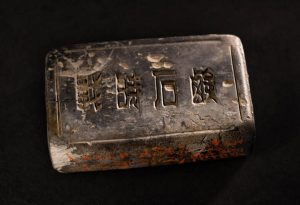Silent Witness: Wartime soap
Nov. 20, 2023
Didn’t melt even in high-temperature fires
by Hiromi Morita, Staff Writer
The dark brown mass, measuring about 4.5 by 7 centimeters, has the appearance of a fossil. The words “wartime soap,” inscribed on the soap’s surface, are clearly visible.
The item is said to have been found in the burned ruins of the home of Yoshio Yamaoka, 29 at the time, in the area of Hakushima Kuken-cho (in what is now Hiroshima’s Naka Ward), about 1.9 kilometers from the hypocenter.
According to the Hiroshima Peace Memorial Museum, located in the city’s Naka Ward, the soap was donated to the museum by Mr. Yamaoka. But other details, such as the timing of the donation, are unknown.
The soap did not melt in the high-temperature fires caused by the atomic bombing probably due to its low oil and fat content.
As the war situation worsened and supplies of oils and fats with which to make soap grew extremely scarce, the war soap was rationed to ordinary people.
The soap is believed to consist primarily of clay and kaolin, with few typical soap ingredients. People used such soap for cleansing the face and body and washing clothes. The single atomic bomb, however, deprived people of even that humble aspect of their lives.
(Originally published on November 20, 2023)








